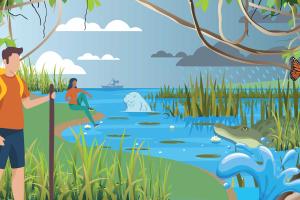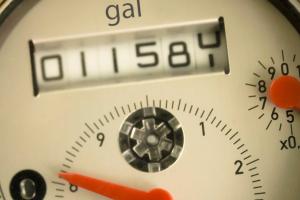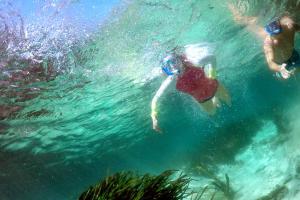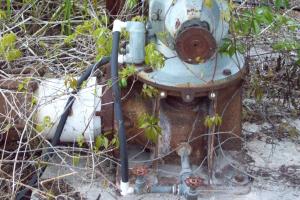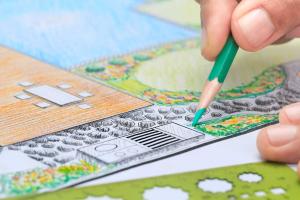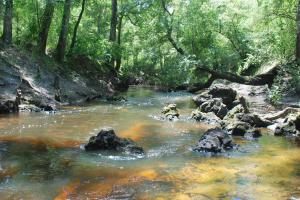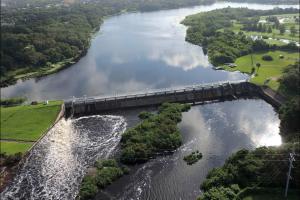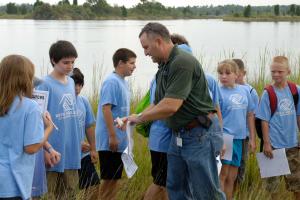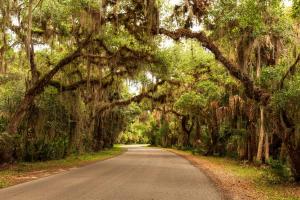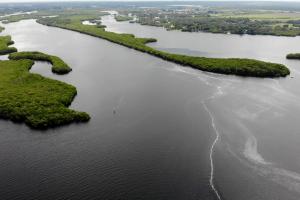Search Content
Displaying results 1801 - 1820 of 4920
The majority of the freshwater supply in west-central Florida comes from groundwater, most commonly the Floridan aquifer system. The Floridan aquifer system contains the largest aquifers within the state and stretches 100,000 square miles beneath Florida and parts of Alabama, Georgia and South Carolina. The Floridan aquifer system has been divided into the Upper Floridan aquifer and Lower Floridan aquifers. Between the aquifers are…
Use your water meter to check for leaks
- Turn off all faucets and water-using appliances and make sure no one uses water during the testing period. Remember to wait for the hot water heater and ice cube makers to refill and for regeneration of water softeners.
- Go to your water meter and record the current reading. Wait 30 minutes. (Remember: no water should be used during this period.)
- Read the meter again. If the reading has changed, you…
We all live in a watershed. That means that what we do on land impacts water bodies both near and far. To protect our water resources, we all must do our part. And sometimes that means preserving habitats that naturally protect water bodies from harmful pollutants, such as our wonderful wetlands!
What are wetlands?
The term wetland refers to a wide variety of aquatic habitats. Wetland ecosystems include swamps,…
What Is Stormwater Runoff?
In Florida, stormwater runoff occurs during or after a rainfall event. Stormwater from the rain flows over impervious, or hard, surfaces like driveways, sidewalks, streets, parking lots and roofs, where it is unable to percolate (filter or seep) into the ground. This unfiltered water then reaches our neighborhood streams, ponds, lakes, bays, wetlands and oceans. It can even make its way into…
It is important to remember that you cannot tell very much about the quality of water simply by looking at it. Most pollutants are invisible to the naked eye. There are three major types of pollutants that affect water quality. Let’s take a look at each type.
Dirt
Rain can wash dirt into rivers and streams. The dirt can smother tiny organisms and kill fish eggs clinging to rocks on the riverbed. Dirt can also clog gills and suffocate fish. Too much…
The purpose of the Public Supply Advisory Committee (PSAC) is to provide professional and technical input into District programs and activities.This includes regulatory programs, rule revisions, water conservation activities, water resource planning, water resource and supply development projects, research and other water resource management projects that relate to the environment. Subject matter considered by the PSAC shall relate to the statutory duties and…
These hands-on activities will help your students learn about water resources.Water Cycle Water Use and Conservation Wetlands Summer Activities Others
WUP Introduction
A quick introduction to the Southwest Florida Water Management District’s Water Use Permitting (WUP) program and instructions on becoming an online registered user.
What is ePIC
A quick introduction to the Southwest Florida Water Management District’s new Online Water Use Permit Information Center (ePIC).
Intro to ePIC
An instructional video for utilizing the Southwest Florida Water Management District’s new Online…
Project WET (Water Education Today)Empowering educators to engage youth to understand water and solve local and global challenges.The Project WET Foundation develops water education resources, provides educator workshops, organizes special water events and has a worldwide network of educators and partners. To learn more about Project WET visit ProjectWET.org or watch the video below. Project…
What is a spring? A spring is a natural opening in the ground where water flows directly from the aquifer to the earth’s surface. The source of this fresh water is from seasonal rainfall that soaks into the ground, which is referred to as groundwater. Springs form when groundwater is under pressure and flows up through an opening called a spring vent, supplying flow to a river or other water body. A spring can occur individually or as a group of many springs. The most…
Assisting the agricultural community by improving the quality of ground water used for irrigation.
Existing wells located in the District’s southern and coastal areas often exhibit water quality conditions that are more highly mineralized with increased well depths. The use of highly mineralized ground water for irrigation purposes can adversely affect both agricultural yields and the water quality of downstream receiving water bodies. Efforts to reduce mineralized…
An efficient irrigation system is designed to deliver the appropriate amount of water to match the needs of turfgrass and plant beds. Irrigation ZonesAn in-ground irrigation system typically waters the landscape in sections instead of all at once. These different sections are referred to as “irrigation zones.” Properly designed irrigation zones are important for three key reasons:
- Not all plants within the landscape need the same amount of water.
- …
KarstMuch of Florida’s landscape is composed of “karst” landforms. Karst terrain is a land surface produced when bedrock — mostly limestone in Florida — dissolves slowly over time as acidic rainwater passes through it. Karst terrain provides a direct connection between surface waters and groundwater and is characterized by springs, sinkholes and caverns.Springs Springs are a common feature of karst topography. They also serve as key tributaries of the…
The District is evaluating the established strategy needed to recover minimum flows adopted for the Lower Hillsborough River. Minimum flows are established to help protect the system from significant harm caused by ground and surface water withdrawals. OverviewMinimum flows are limits established by the District’s Governing Board for surface watercourses that are intended to prevent significant harm to the water resources or ecology of an area that may…
Toilets »
Check for LeaksLeaks inside your toilet can waste up to 200 gallons per day. Some leaks are silent, some produce a running water sound and others may be visible as a small trickle running from the rim to the water in the bowl.To detect silent leaks, remove toilet tank lid and any colored cleaning agents. Make sure there is only clear water in the bowl to start. Add dye tablets, leak detector fluid or a few drops of food coloring to the tank. If the tank is leaking, color…
As director of the Resource Management Division, Jennette Seachrist oversees the bureaus that plan, develop and implement District water resource management initiatives concerning water supply, flood protection, natural systems and water quality. The initiatives include water supply planning and development of alternative water supplies, such as conservation…
Educational tools for teachers and studentsSplash! School Grants: Provides up to $3,000 per school to enhance freshwater resources education. Water Education Videos: Short videos with coordinating teacher’s guides. Topics include: the water cycle, wetlands, watersheds,…
Land and water are forever linked by Florida’s natural water cycles. Lands surrounding lakes, rivers, wetlands and estuaries serve as natural buffers to filter out pollution before it reaches the nearest water body. Undeveloped land can also allow for water recharge to the aquifer in some areas and water storage during major storm events.
The Southwest Florida Water Management District and other agencies and governments purchase conservation lands to…
As assistant executive director, Mandi Rice oversees the day-to-day operations of the District’s five divisions: Resource Management, Regulation, Business & IT Services, Employee, Outreach & General Services, and Operations, Lands & Resource Monitoring.Before joining the District, Rice worked at Tampa Bay Water, Florida’s largest wholesale water supplier, for 18 years in various positions including project manager, senior manager of construction and, most…
Peace River Challenges and RestorationNatural factors, such as the geology of the region and rainfall, contribute to the amount of water recharging the Upper Floridan aquifer and surface water bodies in the area as do human influences, such as groundwater use. There have also been substantial changes to the Peace River watershed over the past 150-200 years, including the clearing, draining and re-contouring of lands for phosphate mining, agriculture and urban…

